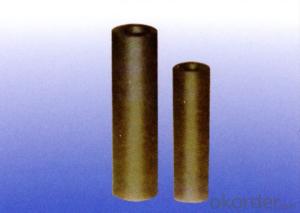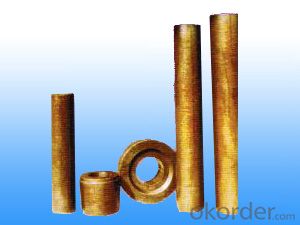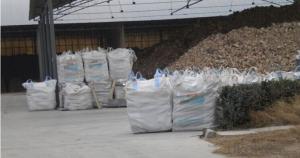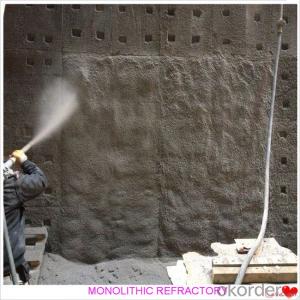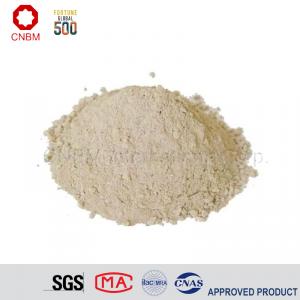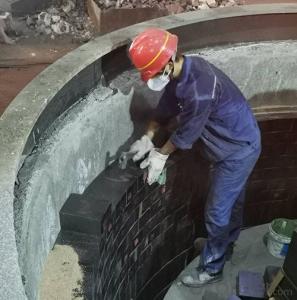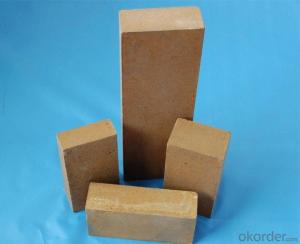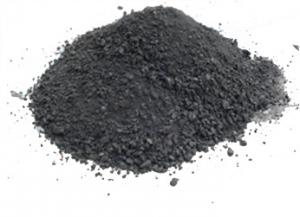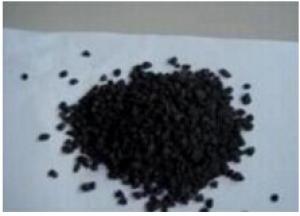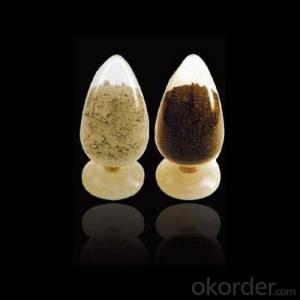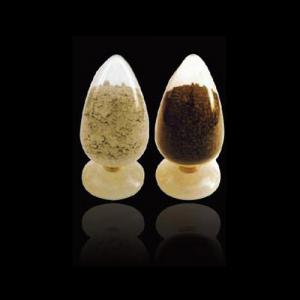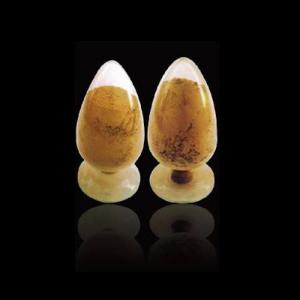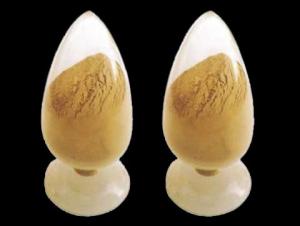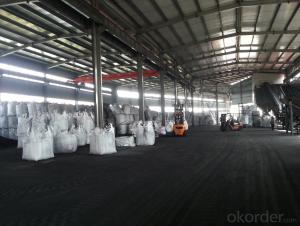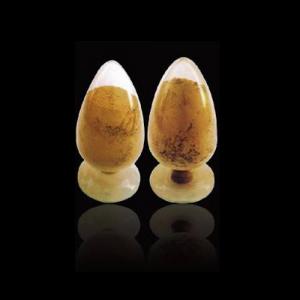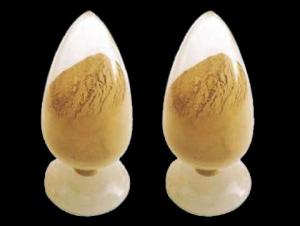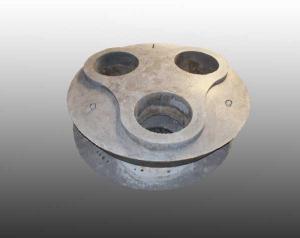Monolithic Refractories for Iron and Steel Industry:Refractory Magnesia Carbon Taphole Bricks for BOF
- Loading Port:
- Shanghai
- Payment Terms:
- TT OR LC
- Min Order Qty:
- 10 set
- Supply Capability:
- 50000 set/month
OKorder Service Pledge
OKorder Financial Service
You Might Also Like
refractory Magnesia carbon taphole bricks for bof
Application unique channel for Pouring steel water from converter
or EAF to ladle
Raw material 99% Large crystal bone material, 599 flake graphite as
binder CaB6 the additive
performance Convenient for changing and construct
Eliminate the steel water leaking from tap hole , improve the safe
ratio apparently
deduct the oxidizing secondly for the steel water
raise the quality of the steel water
much longer service life
( 200 times on converter continue working 25 hours)
Perfect thermal shock ability ,can resist the extreme cold
and hot
Dense structure ,high resistance for washing and erosion
excellent resistance for oxidizing slag and spalling
high refractoriness
Wonderful sinter ability, and adhesion
Specification:
specification | Item | Number |
Chemical | MgO | ≥78% |
C | ≥12% | |
physical | CCS | ≥30MPa |
AP | ≤ 5% | |
BD | ≥2.9g/cm3 | |
Refractoriness | 1500°C-1600°C |
Our Services
Construction To install
Packaging & Shipping
Packing inside: plastic bag
outside: wood carton for sea worthy
FAQ
Store under the room temperature.
for half a year
Pay attention to To be dry ,no hitting
- Q: How are monolithic refractories different from traditional brick refractories?
- There are several differences between monolithic refractories and traditional brick refractories. Firstly, monolithic refractories are composed of a single, homogeneous material, whereas traditional brick refractories are made up of individual bricks that are pieced together. This variance in construction allows monolithic refractories to possess a more uniform and consistent structure, which can enhance their performance and durability. Secondly, installing monolithic refractories is typically easier compared to traditional brick refractories. Due to their composition, they can be poured or sprayed into place, eliminating the need for precise bricklaying and mortar application. This simplified installation process saves time and labor during construction or repair projects. Furthermore, monolithic refractories often exhibit superior resistance to thermal shock when compared to traditional brick refractories. The homogeneous structure of monolithic refractories enables them to expand and contract more uniformly under thermal stress, reducing the risk of cracking and failure. This characteristic makes monolithic refractories more suitable for applications with rapid temperature changes, such as in furnaces or kilns. Additionally, monolithic refractories offer better resistance to chemical attacks and erosion. Traditional brick refractories may have joints and gaps between bricks, which can become vulnerable to chemical reactions or erosion over time. Conversely, monolithic refractories possess a seamless structure that minimizes the risk of chemical penetration and erosion, enhancing their longevity and performance. In conclusion, monolithic refractories provide advantages in terms of uniformity, ease of installation, thermal shock resistance, and chemical resistance compared to traditional brick refractories. These disparities make monolithic refractories the preferred choice for numerous industrial applications that involve high temperatures and harsh environments.
- Q: How do monolithic refractories perform in ladle lining applications in the iron and steel industry?
- Due to their excellent performance and durability, monolithic refractories are extensively utilized in ladle lining applications within the iron and steel industry. These refractories, which consist of a single material composition, offer numerous advantages over traditional brick linings. One significant benefit of employing monolithic refractories in ladle lining applications is their exceptional resistance to thermal shock. Ladles in the iron and steel industry experience extreme temperature fluctuations during the steelmaking process, including the pouring of molten metal and subsequent cooling. To guarantee the integrity of the ladle lining, monolithic refractories are specifically designed to endure these rapid temperature changes without cracking or spalling. In addition to their thermal shock resistance, monolithic refractories also demonstrate excellent resistance to chemical attack. The lining materials of ladles in the iron and steel industry are exposed to highly corrosive molten metal and slag, which can degrade over time. Nevertheless, monolithic refractories are formulated with high-quality raw materials that provide exceptional chemical stability, preventing the erosion and penetration of corrosive substances. Moreover, monolithic refractories offer superior mechanical strength in comparison to traditional brick linings. This is particularly crucial in ladle lining applications, as the lining must withstand the weight of the molten metal and the mechanical stresses associated with ladle handling and transportation. Monolithic refractories possess excellent load-bearing capabilities, ensuring the structural integrity of the ladle lining even under heavy loads. Another advantage of monolithic refractories is their ease of installation. Unlike brick linings, which require meticulous bricklaying, monolithic refractories can be installed using various techniques, such as gunning or casting. This allows for faster and more efficient lining repairs or replacements, reducing downtime during ladle maintenance. Consequently, iron and steel manufacturers can achieve increased productivity and cost savings. In conclusion, monolithic refractories perform exceptionally well in ladle lining applications within the iron and steel industry. Their resistance to thermal shock and chemical attack, superior mechanical strength, and ease of installation make them an ideal choice for ensuring the longevity and reliability of ladles in steelmaking operations.
- Q: What are the advantages of using low-cement castables in the iron and steel industry?
- There are several advantages of using low-cement castables in the iron and steel industry. Firstly, low-cement castables have a lower water requirement compared to conventional castables. This means that less water is needed during the installation process, resulting in a quicker and more efficient installation. Additionally, low water content leads to better strength development and reduced drying time, allowing for faster turnaround times in the production process. Secondly, low-cement castables offer superior resistance to thermal shocks and high temperatures. The iron and steel industry operates at extremely high temperatures, and low-cement castables have excellent refractory properties that can withstand these harsh conditions. This ensures a longer service life for the refractory lining and reduces the need for frequent repairs or replacements. Furthermore, low-cement castables exhibit excellent mechanical strength and abrasion resistance. The iron and steel industry involves the handling of heavy materials and abrasive substances, which can cause wear and tear on the refractory lining. Low-cement castables have the ability to withstand these mechanical stresses, thereby increasing the durability and longevity of the lining. Moreover, low-cement castables have a low porosity and high density, which results in reduced permeability. This makes them highly resistant to alkali attacks, chemical corrosion, and slag penetration, which are common challenges faced in the iron and steel industry. By using low-cement castables, the risk of refractory failure due to these corrosive elements is minimized. Lastly, low-cement castables offer improved energy efficiency. Their lower thermal conductivity means that less heat is conducted through the refractory lining, resulting in reduced heat losses. This leads to energy savings, as less heat is wasted and more heat is retained in the system. This is particularly advantageous in the iron and steel industry, where energy costs can be significant. In summary, the advantages of using low-cement castables in the iron and steel industry include reduced water requirement, superior thermal resistance, enhanced mechanical strength, improved resistance to chemical corrosion, and increased energy efficiency. These benefits contribute to overall cost savings, increased productivity, and improved operational performance in the iron and steel manufacturing process.
- Q: How do monolithic refractories impact the overall productivity of iron and steel operations?
- Monolithic refractories play a crucial role in enhancing the overall productivity of iron and steel operations. These refractories are specially designed to withstand extreme temperatures, chemical reactions, and mechanical stress that occur during the production process. One significant impact of monolithic refractories on productivity is their ability to reduce downtime and increase operational efficiency. The high thermal conductivity and resistance to thermal shock of these refractories enable them to maintain stable temperatures within the furnace, preventing sudden temperature fluctuations that can cause equipment failure and production delays. This, in turn, ensures a continuous and uninterrupted production process, leading to increased productivity. Moreover, monolithic refractories offer superior corrosion resistance, preventing the erosion and degradation of furnace linings. This resistance to chemical attacks from molten metals and slag helps prolong the lifespan of the refractory lining, reducing the frequency of repairs and replacements. Consequently, the reduced maintenance requirements translate into less downtime and higher productivity for iron and steel operations. Additionally, monolithic refractories facilitate faster installation and repair processes compared to traditional brick refractories. Their fluid-like nature allows for easy application and shaping, resulting in shorter installation and curing times. This quick turnaround time minimizes production interruptions during repairs or maintenance, further enhancing overall productivity. Furthermore, the use of monolithic refractories can optimize energy consumption in iron and steel operations. Their excellent insulation properties help retain heat within the furnace, reducing heat loss and energy waste. This leads to improved energy efficiency and cost savings, contributing to increased productivity and profitability. In summary, monolithic refractories have a significant impact on the overall productivity of iron and steel operations. Their ability to withstand extreme conditions, reduce downtime, resist corrosion, facilitate quick repairs, and optimize energy consumption all contribute to improved efficiency and productivity in the industry.
- Q: What are the typical operating temperatures for monolithic refractories?
- The typical operating temperatures for monolithic refractories vary depending on the specific composition and type of refractory material. However, in general, monolithic refractories are designed to withstand high temperatures ranging from 1500°C (2732°F) to 1800°C (3272°F) and even higher in some cases. These refractories are commonly used in industries such as steelmaking, cement production, glass manufacturing, and petrochemical processing, where they are subjected to extreme thermal conditions. Different types of monolithic refractories have different temperature limits. For instance, basic refractories made of magnesia or dolomite can withstand temperatures up to 1800°C (3272°F). On the other hand, alumina-based refractories can typically handle temperatures up to 1700°C (3092°F). Silicon carbide-based refractories have even higher temperature resistance, with the ability to withstand temperatures above 2000°C (3632°F). It is crucial to select the appropriate monolithic refractory material based on the specific operating temperature requirements of the application. Using refractories beyond their recommended temperature limits can cause thermal shock, spalling, or reduced performance, leading to potential equipment failure or safety hazards. Therefore, consulting with refractory manufacturers or experts in the field is essential to ensure the correct selection and optimal performance of monolithic refractories in high-temperature applications.
- Q: What types of monolithic refractories are commonly used in the iron and steel industry?
- In the iron and steel industry, several types of monolithic refractories are commonly used due to their high resistance to extreme temperatures and mechanical stresses. These refractories are essential for lining furnaces, ladles, and other equipment used in the production of iron and steel. One commonly used monolithic refractory in this industry is castable refractory. It is a mixture of refractory aggregates, binders, and additives that can be poured or cast into various shapes and sizes. Castable refractories are versatile and can be easily installed, making them suitable for lining large furnaces and ladles. They offer good thermal insulation and excellent resistance to thermal shocks. Another type of monolithic refractory used in the iron and steel industry is plastic refractory. It consists of a high-alumina refractory aggregate mixed with a bonding agent, usually clay. Plastic refractories have a high plasticity and can be easily shaped by hand or with a trowel. They are commonly used for repairs and patching in furnaces and ladles. Ramming refractories are also commonly employed in the iron and steel industry. These refractories are made of granular refractory materials mixed with a binder. They are installed by ramming the mixture into the desired shape using a pneumatic hammer or manual ramming tools. Ramming refractories offer high resistance to abrasion and erosion, making them suitable for lining the bottoms of furnaces and other areas subjected to intense mechanical wear. Lastly, gunning refractories are frequently used in the iron and steel industry. Gunning refractories are made of fine refractory powders mixed with water or a bonding agent. They are applied using a gunning machine, which propels the refractory material onto the surface to be lined. Gunning refractories are commonly used for repairing and maintaining the linings of ladles, tundishes, and other equipment. Overall, the iron and steel industry relies on a variety of monolithic refractories such as castables, plastics, rammings, and gunnings to ensure the reliable and efficient operation of their equipment in high-temperature environments. These refractories provide excellent thermal insulation, resistance to thermal shocks, and mechanical strength essential for the production of iron and steel.
- Q: Can monolithic refractories be used for the lining of reheating furnaces and walking beam furnaces?
- Monolithic refractories, which are refractory materials that can be cast or gunned into place rather than being made up of individual bricks or precast shapes, can be utilized for the lining of both reheating furnaces and walking beam furnaces. This characteristic makes them highly adaptable and versatile for a variety of furnace applications. Reheating furnaces are employed to heat metal products to a specific temperature before undergoing further processing, such as rolling or forging. The lining of these furnaces is exposed to high temperatures, thermal cycling, and mechanical stress. Given their exceptional thermal shock resistance and ability to withstand rapid temperature changes without cracking or spalling, monolithic refractories are well-suited for these conditions. In the steel industry, walking beam furnaces are utilized for the continuous heating and transportation of steel slabs or billets. These furnaces necessitate a lining material that can endure the abrasion and mechanical stress caused by the movement of the material. Monolithic refractories with high abrasion resistance and good mechanical strength are ideal for lining walking beam furnaces. Moreover, monolithic refractories provide additional advantages such as straightforward installation, decreased downtime for repairs, and enhanced energy efficiency. They can be customized to fit specific furnace designs and can be easily repaired or replaced as needed. In conclusion, monolithic refractories are a suitable option for lining reheating furnaces and walking beam furnaces due to their ability to withstand high temperatures, thermal cycling, mechanical stress, and abrasion. Their versatility, ease of installation, and repair make them the preferred choice for these furnace applications.
- Q: How can the lifespan of monolithic refractories be extended in the iron and steel industry?
- The lifespan of monolithic refractories in the iron and steel industry can be extended through various measures. Firstly, proper installation and maintenance of the refractories is crucial. This includes ensuring that the refractories are correctly shaped and sized to fit the specific application, as well as using appropriate installation techniques and materials. Regular inspections should be conducted to identify any signs of wear or damage, and immediate repairs or replacements should be carried out to prevent further deterioration. Secondly, implementing effective heat management practices can significantly prolong the lifespan of monolithic refractories. This involves monitoring and controlling the temperature gradients within the refractory lining to prevent thermal shock and excessive thermal cycling. Adequate insulation and cooling systems should also be in place to maintain a stable and controlled environment. Furthermore, proper handling and operation of the equipment and processes can contribute to extending the refractory lifespan. Avoiding sudden temperature changes, minimizing mechanical stress and impact, and employing appropriate operating procedures can help reduce the wear and tear on the refractories. Additionally, utilizing advanced refractory materials and technologies can enhance the lifespan of monolithic refractories. The development and use of high-performance and specialized refractories, such as advanced ceramics or specialized coatings, can provide increased resistance to thermal and chemical degradation, ultimately extending their lifespan. Lastly, continuous research and development efforts should be undertaken to explore innovative solutions for refractory longevity in the iron and steel industry. Collaborating with suppliers, experts, and industry partners can help identify and implement new technologies and techniques that can improve the durability and performance of monolithic refractories. In summary, extending the lifespan of monolithic refractories in the iron and steel industry requires a combination of proper installation and maintenance, effective heat management, careful handling and operation, utilization of advanced materials, and ongoing research and development. By implementing these strategies, the iron and steel industry can optimize refractory performance and reduce downtime and costs associated with frequent replacements.
- Q: How do monolithic refractories prevent heat loss through radiation?
- Monolithic refractories prevent heat loss through radiation by their high thermal conductivity and low thermal expansion. These properties allow them to efficiently transfer heat from the hot side of the refractory to the cooler side, minimizing the temperature difference and reducing heat loss through radiation. Additionally, monolithic refractories provide a continuous and seamless lining, eliminating gaps and cracks that could allow heat to escape. The dense and compact structure of monolithic refractories also acts as a barrier to prevent radiation heat transfer. Overall, monolithic refractories play a crucial role in maintaining thermal insulation and preventing heat loss through radiation in various high-temperature applications.
- Q: How does the choice of monolithic refractory impact the overall cost of iron and steel production?
- The choice of monolithic refractory can have a significant impact on the overall cost of iron and steel production. Monolithic refractory refers to a type of refractory material that is installed in a continuous manner, as opposed to traditional brick or tile refractories. One key factor that affects the cost of iron and steel production is the lifespan of the refractory. Monolithic refractories generally have a longer lifespan compared to traditional brick or tile refractories. This means that they require less frequent maintenance and replacement, resulting in lower overall costs over time. Additionally, monolithic refractories have a higher resistance to thermal shock and mechanical stress, which further extends their lifespan and reduces the need for repairs and replacements. Another important consideration is the energy efficiency of the monolithic refractory. These refractories have better insulation properties, which leads to reduced heat loss during the iron and steel production process. This helps to lower energy consumption and, consequently, the overall cost of production. The improved insulation also contributes to a more stable and controlled temperature profile within the furnace, resulting in better product quality and reduced scrap rates. Furthermore, monolithic refractories offer greater flexibility in terms of installation and repair. They can be easily applied to complex shapes and structures, allowing for more efficient use of refractory materials. This reduces waste and lowers material costs. The ease of installation also saves time and labor, further contributing to cost savings. Additionally, monolithic refractories are known for their superior performance in high-temperature environments. They exhibit excellent thermal conductivity and resistance to chemical attacks, ensuring optimal furnace operation and reducing the likelihood of downtime and production delays. This, in turn, minimizes the impact of unexpected maintenance, repairs, and shutdowns on the overall cost of iron and steel production. In conclusion, the choice of monolithic refractory can have a significant impact on the overall cost of iron and steel production. Its longer lifespan, improved energy efficiency, ease of installation and repair, and superior performance in high-temperature environments all contribute to cost savings in various aspects of the production process. Thus, careful consideration of the type of monolithic refractory used can result in significant cost reductions and improved overall efficiency in iron and steel production.
Send your message to us
Monolithic Refractories for Iron and Steel Industry:Refractory Magnesia Carbon Taphole Bricks for BOF
- Loading Port:
- Shanghai
- Payment Terms:
- TT OR LC
- Min Order Qty:
- 10 set
- Supply Capability:
- 50000 set/month
OKorder Service Pledge
OKorder Financial Service
Similar products
Hot products
Hot Searches
Related keywords
